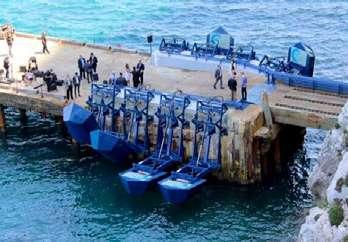|
I |N |N |O |V |A |T|I |O |N |S|
Researchers Create 68.9%-efficient PV Cell for Laser energy Transmission
A
t the recently held 48th IEEE Photovoltaic Specialists Conference, researchers from the Fraunhofer Institute for Solar Energy Systems ISE presented their achievement of a record conversion efficiency of 68.9% for a photovoltaic cell under monochromatic laser light. The scientists at Fraunhofer ISE claimed the success, explaining that it was made possible with a special thin film technology in which the solar cell layers were first grown on a gallium arsenide substrate which was then subsequently removed. A conductive, highly reflective mirror was applied to the back surface of the remaining semiconductor structure, which was only a few micrometers thick. This was their process: Photovoltaic cells convert light into electricity. The incoming light is absorbed in a cell structure, made of gallium arsenide semiconductor material, for example. The absorbed light sets positive and negative charges free, which are
in turn conducted to the front and back cell contacts, generating electricity. This “photovoltaic effect” is particularly efficient when the energy of the incident light lies slightly above the so-called bandgap energy inherent to the semiconductor material. Thus, very high efficiencies are theoretically possible when a monochromatic laser as light source is matched with a suitable semiconductor compound material. In this new form of energy transfer, called power by light, the laser energy is delivered either through the air or via an optical fiber to a photovoltaic cell whose properties match the power and the wavelength of the monochromatic laser light. Compared to conventional power transmission via copper wires, power by light systems are especially beneficial for applications which require a galvanically isolated power supply, lightning or explosion protection, electromagnetic compatibility, or completely wireless power transmission, for example.
“This thin film approach has two distinct advantages for the efficiency,” explains the physicist Dr. Henning Helmers, head of the Fraunhofer ISE research team. “First of all, photons are trapped in the cell and the absorption is maximized for photon energies close to the band gap, which simultaneously minimizes thermalization and transmission losses, making the cell more efficient. Secondly, the photons additionally generated internally by radiative recombination become trapped and effectively recycled. This extends the effective carrier lifetime, thus additionally increasing the voltage.” The research group investigated thin film photovoltaic cells with back-surface reflectors made of gold and an optically optimized combination of ceramic and silver, with the latter showing the best results. An n-GaAs/p-AlGaAs heterostructure was developed as absorber, which shows particularly low charge carrier losses due to recombination.
Ultrasonic Delamination Could Make Battery Recovery Quick & Green
R
esearchers from the universities of Birmingham and Leicester, working at Faraday Institution on ‘ReLiB’, a battery recycling research project, claim that ultrasonic delamination is a fast, sustainable, and less energyintensive method to recycle batteries. While old batteries are usually shredded and treated with fire or aqueous solvents to recover precious metals, a process that uses a lot of energy and releases toxic waste, these U.K. scientists have advocated the use of ultrasonic sound waves for battery recovery in their paper “Lithium-ion Battery Recycling Using High-intensity Ultrasonication,” recently published in the journal Green
38
Chemistry. The paper, which argues that this process could also yield higher-purity materials, was co-authored by Chunhong Lei, Iain Aldous, Jennifer Hartley, Dana Thompson, Sean Scott , Rowan Hanson, Paul Anderson, Emma Kendrick, Rob Sommerville, Karl Ryder, and Andrew Abbott. According to the scientists, decarbonisation of energy will rely heavily, at least initially, on the use of lithium ion batteries for automotive transportation. The projected volumes of batteries necessitate the development of fast and efficient recycling protocols. Current methods are based on either hydrometallurgical or pyrometallurgical methods.
SAUR ENERGY INTERNATIONAL J U LY 2 02 1 SAURENERGY .C O M
The development of efficient separation techniques of waste lithium ion batteries into processable waste streams is needed to reduce material loss during recycling. In their paper, they show a rapid and simple method for removing the active material from composite electrodes using high powered ultrasound in a continuous flow process. Cavitation at the electrode interface enables rapid and selective breaking of the adhesive bond, enabling an electrode to be delaminated in a matter of seconds. This enables the amount of material that can be processed in a given time and volume to be increased by a factor of approximately 100. It also produces a material of higher purity and value that can
potentially be directly recycled into new electrodes. The researchers say that the efficiency of the delamination process is strongly affected by the type of polymer binder with water-dispersible binders such as SBR/CMC being more rapidly stripped. Delamination could thus be further optimised using wetting agents and pH modification. Production scrap from the batteries could be rapidly recycled by simply wetting the active material/ binder mixture with an organic solvent. High rates of material recovery and throughput coupled with the ease of process scale up make high-powered ultrasonic delamination a stepchange in battery recycling, the scientists conclude.









